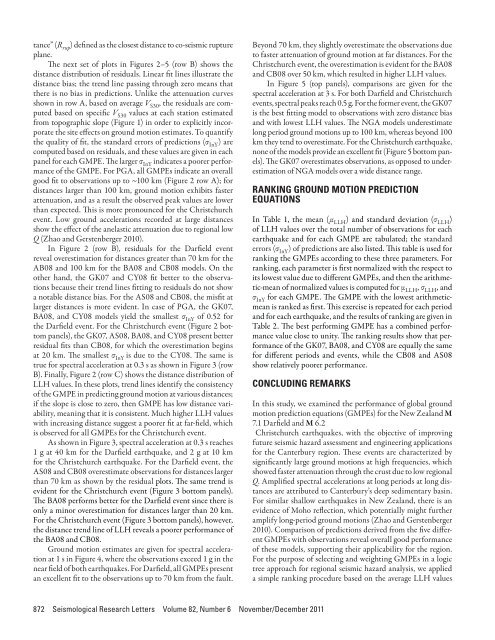Here - Stuff
Here - Stuff
Here - Stuff
Create successful ePaper yourself
Turn your PDF publications into a flip-book with our unique Google optimized e-Paper software.
tance” (R rup ) defined as the closest distance to co-seismic ruptureplane.The next set of plots in Figures 2–5 (row B) shows thedistance distribution of residuals. Linear fit lines illustrate thedistance bias; the trend line passing through zero means thatthere is no bias in predictions. Unlike the attenuation curvesshown in row A, based on average V S30 , the residuals are computedbased on specific V S30 values at each station estimatedfrom topographic slope (Figure 1) in order to explicitly incorporatethe site effects on ground motion estimates. To quantifythe quality of fit, the standard errors of predictions (σ InY ) arecomputed based on residuals, and these values are given in eachpanel for each GMPE. The larger σ InY indicates a poorer performanceof the GMPE. For PGA, all GMPEs indicate an overallgood fit to observations up to ~100 km (Figure 2 row A); fordistances larger than 100 km, ground motion exhibits fasterattenuation, and as a result the observed peak values are lowerthan expected. This is more pronounced for the Christchurchevent. Low ground accelerations recorded at large distancesshow the effect of the anelastic attenuation due to regional lowQ (Zhao and Gerstenberger 2010).In Figure 2 (row B), residuals for the Darfield eventreveal overestimation for distances greater than 70 km for theAB08 and 100 km for the BA08 and CB08 models. On theother hand, the GK07 and CY08 fit better to the observationsbecause their trend lines fitting to residuals do not showa notable distance bias. For the AS08 and CB08, the misfit atlarger distances is more evident. In case of PGA, the GK07,BA08, and CY08 models yield the smallest σ InY of 0.52 forthe Darfield event. For the Christchurch event (Figure 2 bottompanels), the GK07, AS08, BA08, and CY08 present betterresidual fits than CB08, for which the overestimation beginsat 20 km. The smallest σ InY is due to the CY08. The same istrue for spectral acceleration at 0.3 s as shown in Figure 3 (rowB). Finally, Figure 2 (row C) shows the distance distribution ofLLH values. In these plots, trend lines identify the consistencyof the GMPE in predicting ground motion at various distances;if the slope is close to zero, then GMPE has low distance variability,meaning that it is consistent. Much higher LLH valueswith increasing distance suggest a poorer fit at far-field, whichis observed for all GMPEs for the Christchurch event.As shown in Figure 3, spectral acceleration at 0.3 s reaches1 g at 40 km for the Darfield earthquake, and 2 g at 10 kmfor the Christchurch earthquake. For the Darfield event, theAS08 and CB08 overestimate observations for distances largerthan 70 km as shown by the residual plots. The same trend isevident for the Christchurch event (Figure 3 bottom panels).The BA08 performs better for the Darfield event since there isonly a minor overestimation for distances larger than 20 km.For the Christchurch event (Figure 3 bottom panels), however,the distance trend line of LLH reveals a poorer performance ofthe BA08 and CB08.Ground motion estimates are given for spectral accelerationat 1 s in Figure 4, where the observations exceed 1 g in thenear field of both earthquakes. For Darfield, all GMPEs presentan excellent fit to the observations up to 70 km from the fault.Beyond 70 km, they slightly overestimate the observations dueto faster attenuation of ground motion at far distances. For theChristchurch event, the overestimation is evident for the BA08and CB08 over 50 km, which resulted in higher LLH values.In Figure 5 (top panels), comparisons are given for thespectral acceleration at 3 s. For both Darfield and Christchurchevents, spectral peaks reach 0.5 g. For the former event, the GK07is the best fitting model to observations with zero distance biasand with lowest LLH values. The NGA models underestimatelong period ground motions up to 100 km, whereas beyond 100km they tend to overestimate. For the Christchurch earthquake,none of the models provide an excellent fit (Figure 5 bottom panels).The GK07 overestimates observations, as opposed to underestimationof NGA models over a wide distance range.RANKING GROUND MOTION PREDICTIONEQUATIONSIn Table 1, the mean (μ LLH ) and standard deviation (σ LLH )of LLH values over the total number of observations for eachearthquake and for each GMPE are tabulated; the standarderrors (σ InY ) of predictions are also listed. This table is used forranking the GMPEs according to these three parameters. Forranking, each parameter is first normalized with the respect toits lowest value due to different GMPEs, and then the arithmetic-meanof normalized values is computed for μ LLH , σ LLH , andσ InY for each GMPE. The GMPE with the lowest arithmeticmeanis ranked as first. This exercise is repeated for each periodand for each earthquake, and the results of ranking are given inTable 2. The best performing GMPE has a combined performancevalue close to unity. The ranking results show that performanceof the GK07, BA08, and CY08 are equally the samefor different periods and events, while the CB08 and AS08show relatively poorer performance.CONCLUDING REMARKSIn this study, we examined the performance of global groundmotion prediction equations (GMPEs) for the New Zealand M7.1 Darfield and M 6.2Christchurch earthquakes, with the objective of improvingfuture seismic hazard assessment and engineering applicationsfor the Canterbury region. These events are characterized bysignificantly large ground motions at high frequencies, whichshowed faster attenuation through the crust due to low regionalQ. Amplified spectral accelerations at long periods at long distancesare attributed to Canterbury’s deep sedimentary basin.For similar shallow earthquakes in New Zealand, there is anevidence of Moho reflection, which potentially might furtheramplify long-period ground motions (Zhao and Gerstenberger2010). Comparison of predictions derived from the five differentGMPEs with observations reveal overall good performanceof these models, supporting their applicability for the region.For the purpose of selecting and weighting GMPEs in a logictree approach for regional seismic hazard analysis, we applieda simple ranking procedure based on the average LLH values872 Seismological Research Letters Volume 82, Number 6 November/December 2011
















